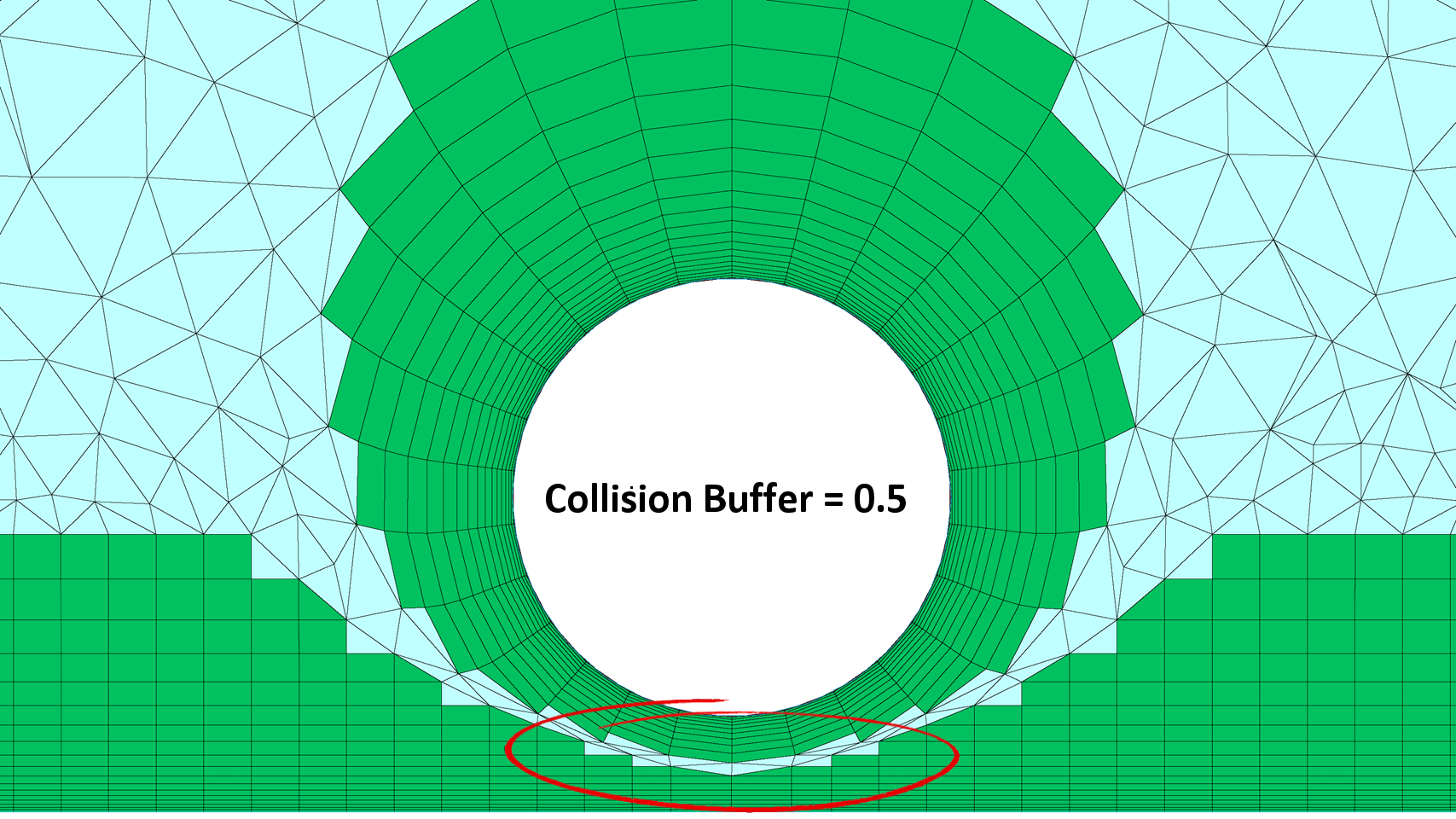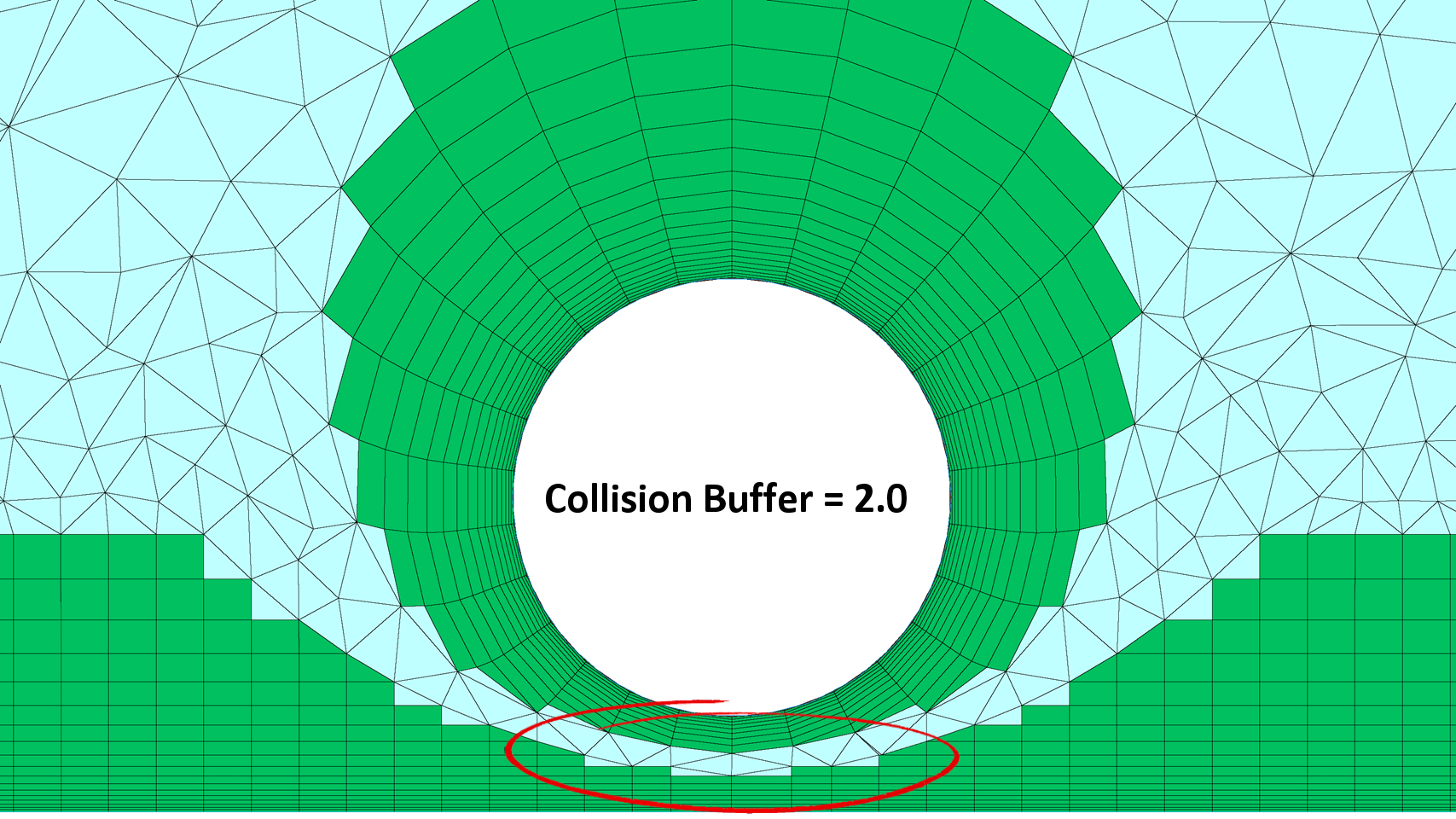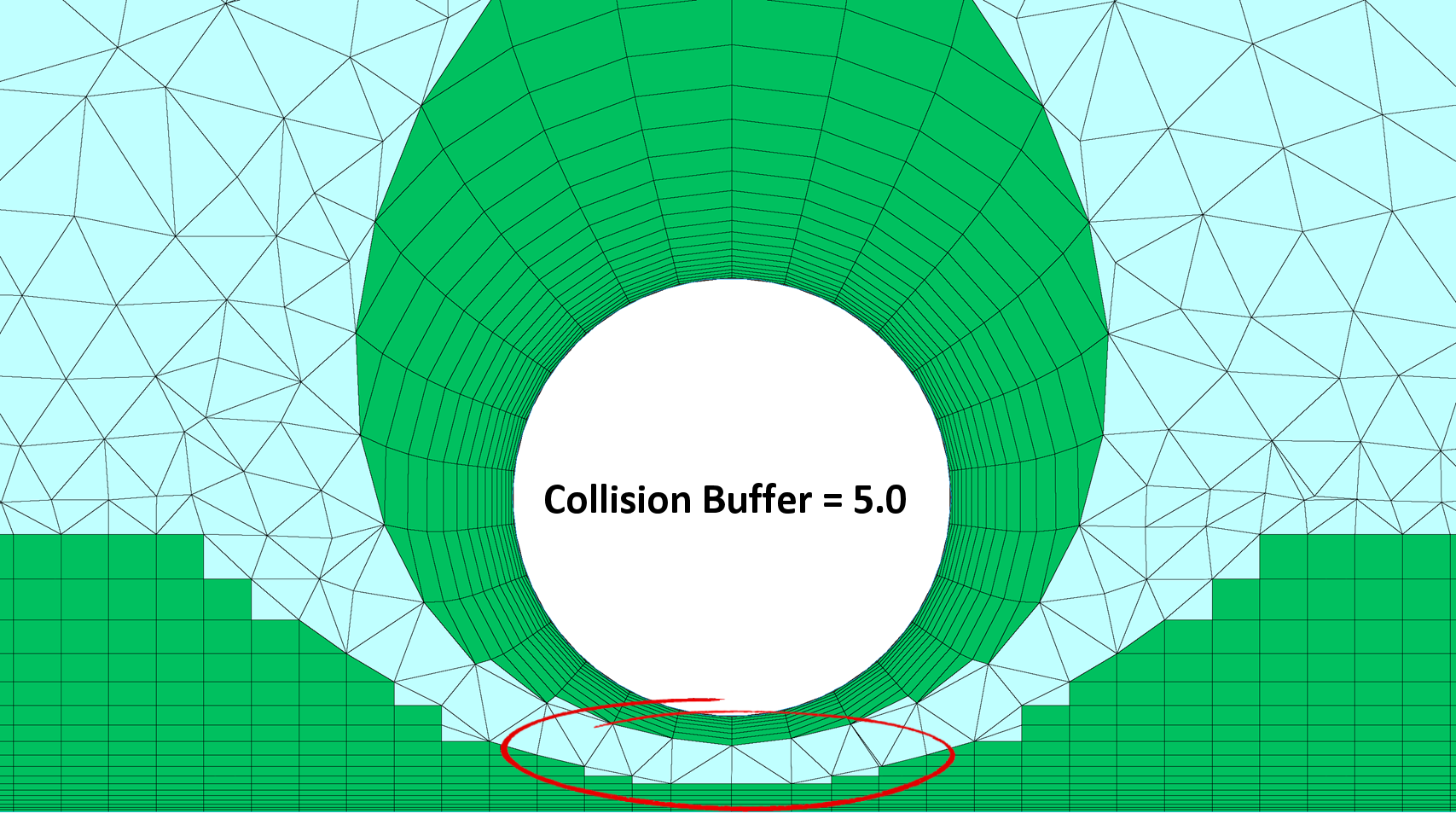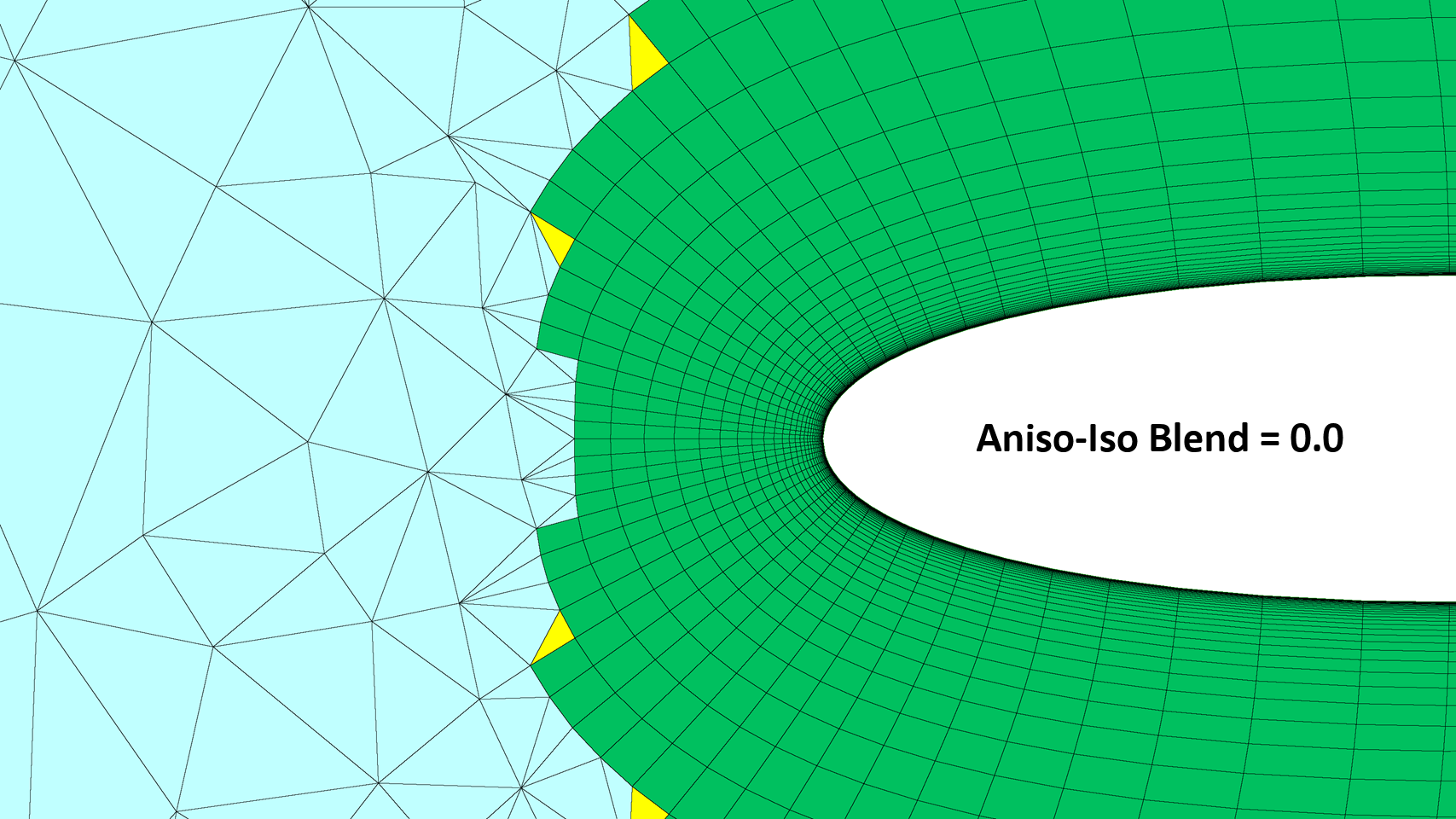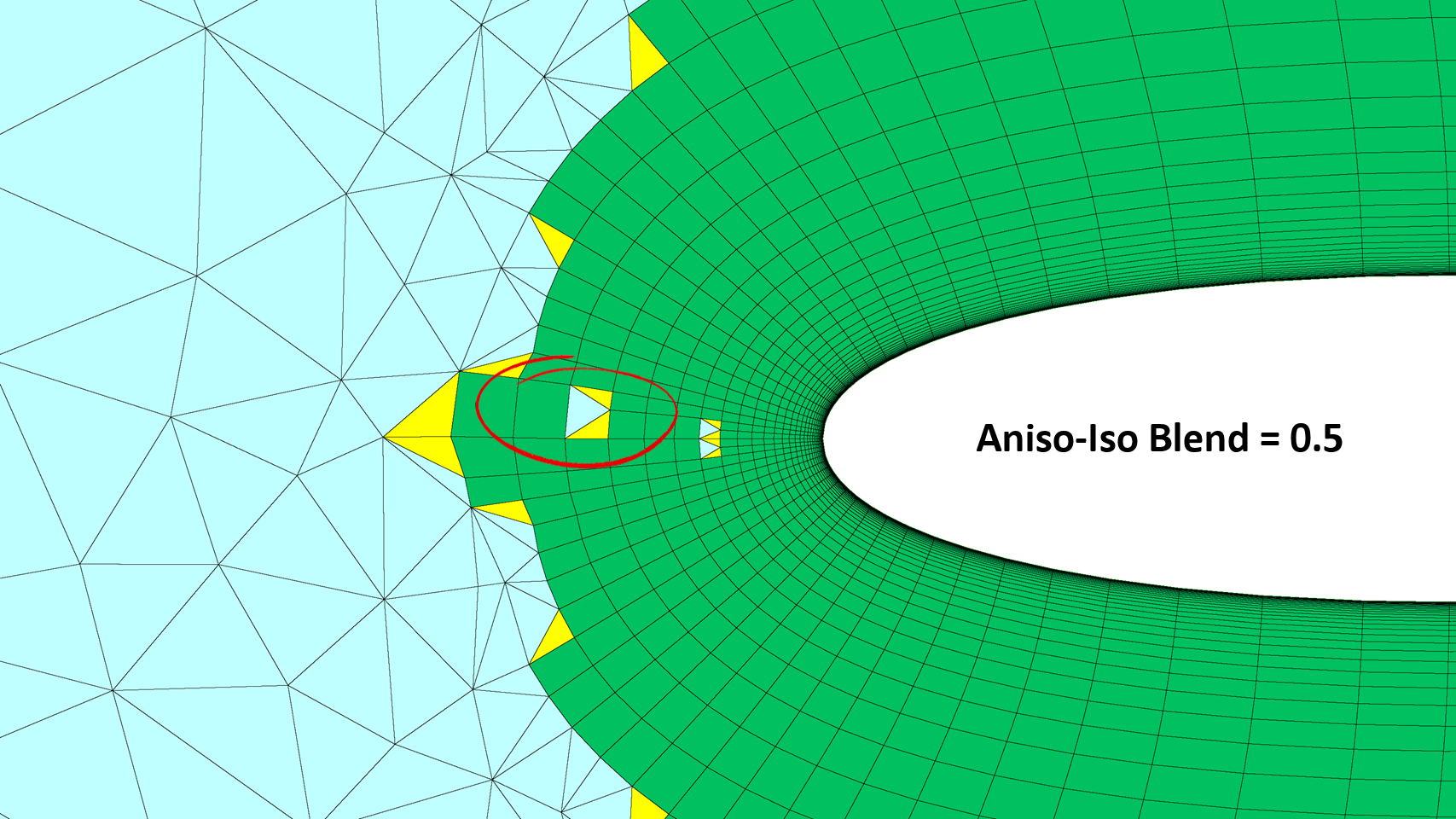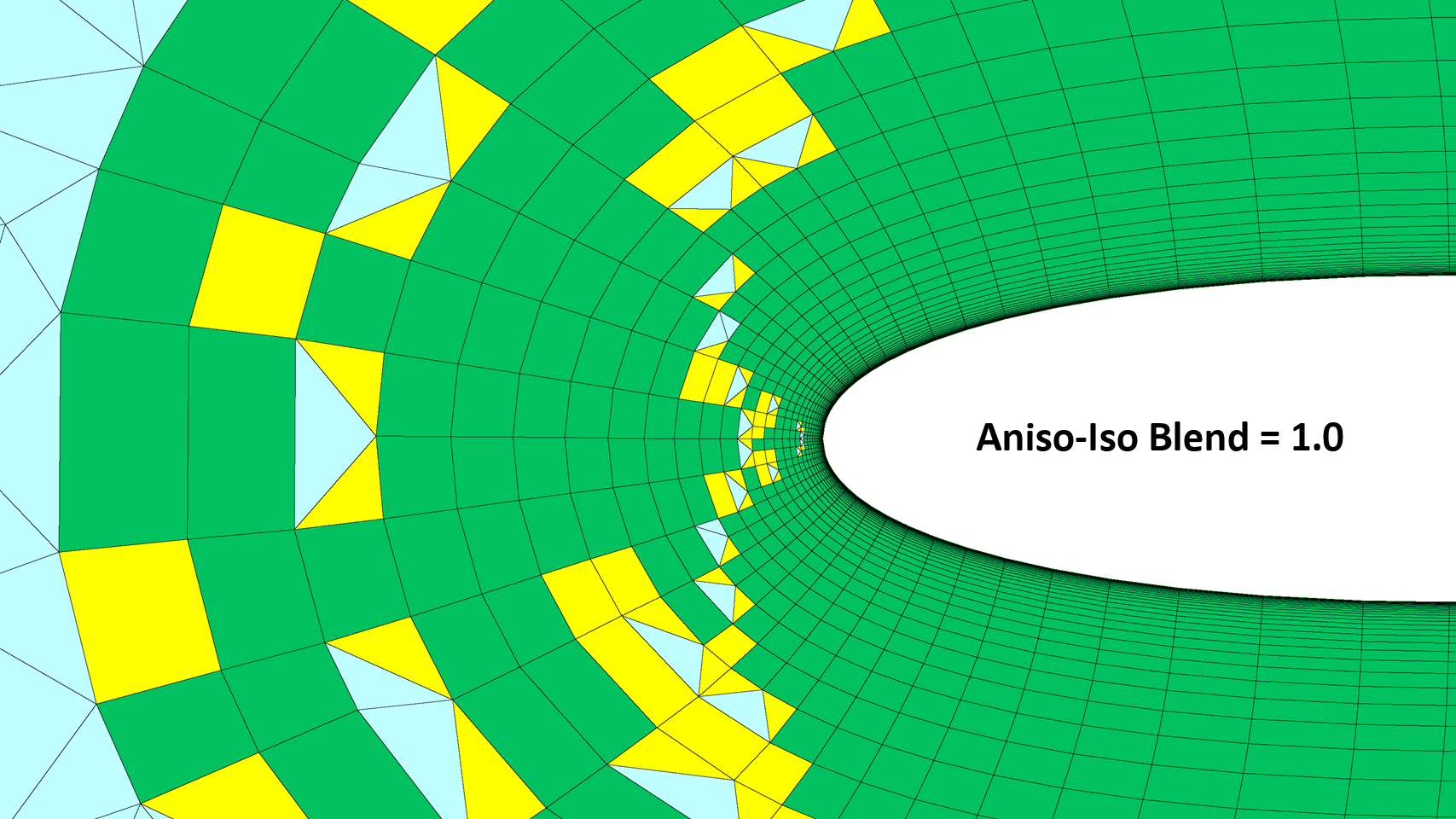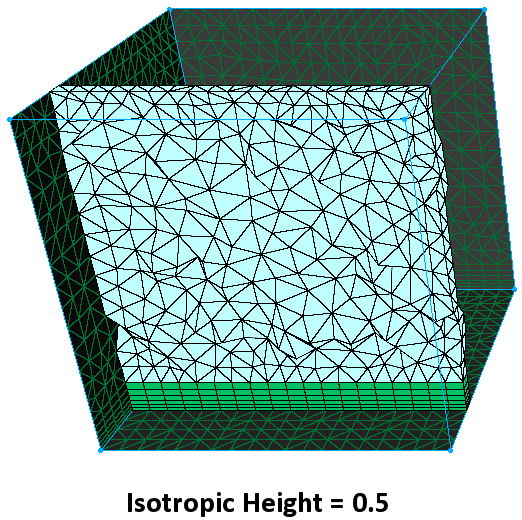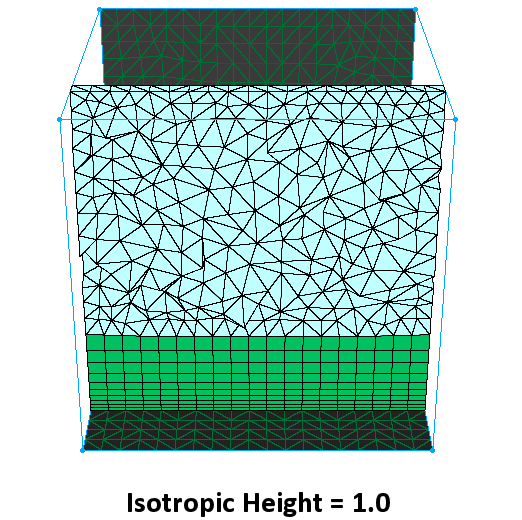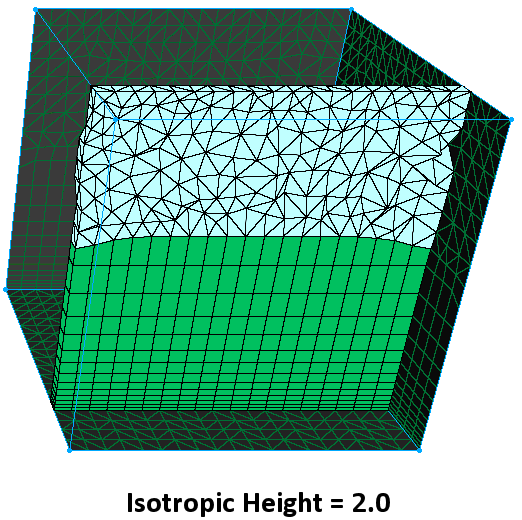Description
The T-Rex tab (figure below) allows you to generate anisotropic layers from the boundaries of unstructured blocks. Options are available to choose the type of cells contained in those layers: tetrahedra and pyramids or a combination of tetrahedra, pyramids, prisms, and hexahedra. If you chose to generate anisotropic layers containing only tetrahedra and pyramids, note that it is possible to combine these cells into prisms and hexahedra using the Combine T-Rex Cells command. Combination into hexahedral cells can only occur where T-Rex layers are grown from structured domains.
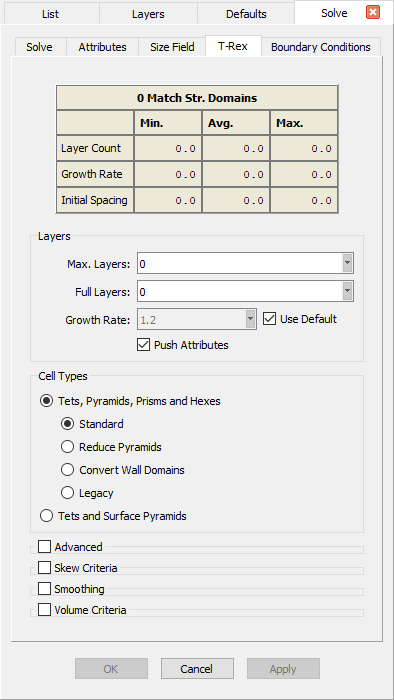
At the top of the T-Rex tab, a table provides information regarding structured domains which have been assigned to a Match T-Rex boundary condition (refer to the Boundary Conditions section for more information). Since the Push Attributes feature (described below) will not affect these domains in order to avoid unwanted modifications to the adjacent blocks using them, the information displayed on the table is intended to help you determine the appropriate settings for the T-Rex algorithm.
The top of the table shows the total number of match structured domains. The table also shows the calculated Layer Count, the calculated Growth Rate, and the Initial Spacing for such domains. Since multiple structured domains assigned to T-Rex Match boundary conditions may exist, minimum, average, and maximum values are provided for each measure.
Layers
In the Layers frame you will find the basic settings for generating anisotropic tetrahedra layers in an unstructured block. These settings apply specifically to those boundaries of a block which have been set to type Wall in the Boundary Conditions tab (refer to the Boundary Conditions section for more information).
Use Max. Layers to set the total number of anisotropic tetrahedra layers you wish to generate. This is a target number only. Various physical constraints and quality controls may prevent this target from being achieved. A value of 0 input for Max. Layers turns off the T-Rex anisotropic meshing.
Use Full Layers to set a target for the number of layers you wish to generate without any changes in the deforming front (i.e. the number of target layers to generate prior to any refinement or decimation of the front). This parameter also controls whether the T-Rex solver applies multiple normals (Full Layers = 0) along sharp edges or not (Full Layers > 0).
Tip: Always set Full Layers to 0 (zero) when applying T-Rex layers to baffles. This allows the solver to apply multiple normals along the sharp edges of a baffle which otherwise would not be applied, resulting in fewer layers on the baffle and significant scalloping of the layers that are completed. See the image below for an example.
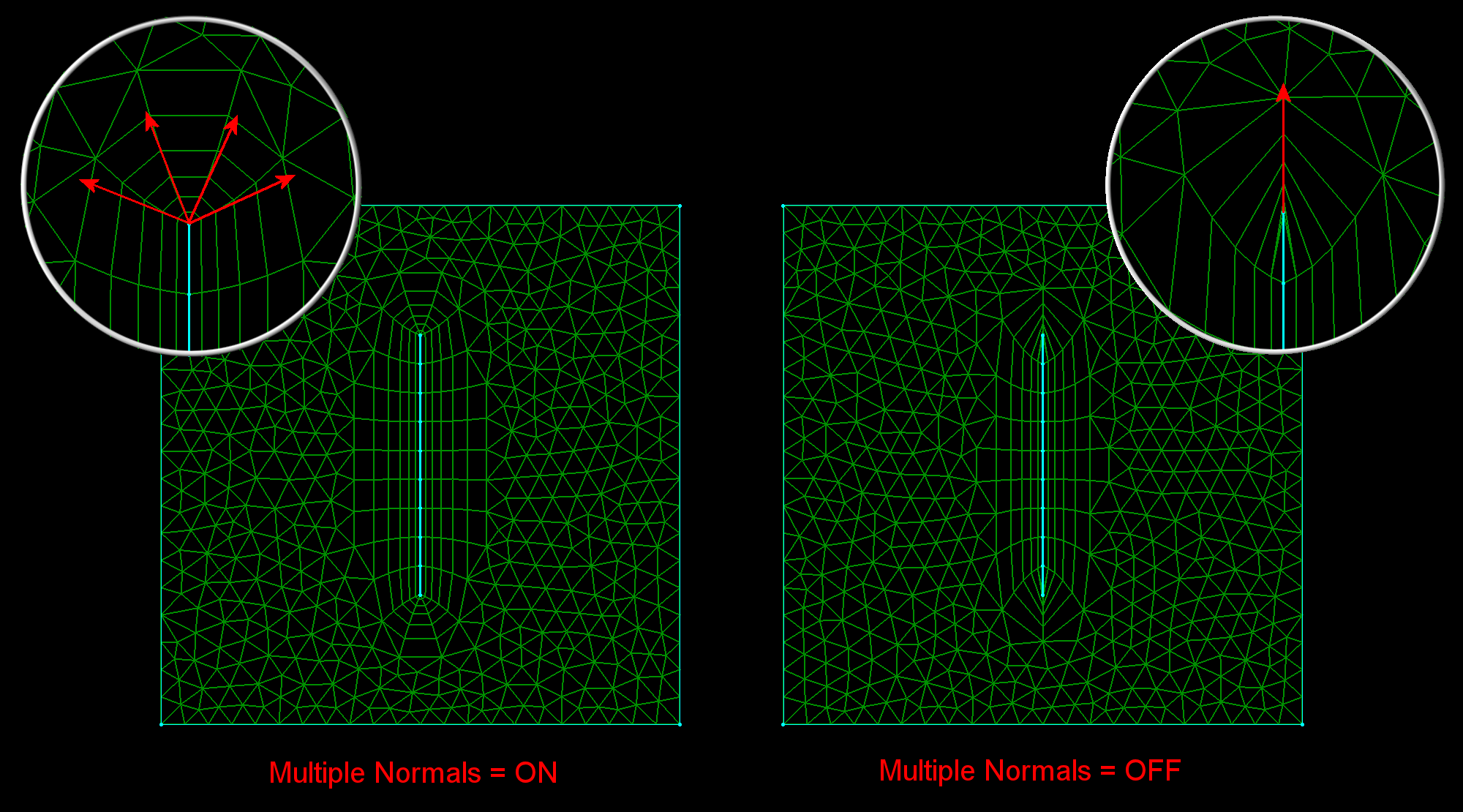
Tip: Always set Full Layers to 0 (zero) in situations where a growth domain (i.e. set to a Wall T-Rex boundary condition) is nearly coplanar to a symmetry domain (i.e. set to a Match T-Rex boundary condition). This allows the solver to apply multiple normals in this region greatly improving the quality of the final volume cells.
The image below presents a sample case where the vertical stabilizer of an aircraft model has a sharp trailing edge. In cases where only half the model needs to be meshed, the result is a vertical stabilizer (growth) domain almost coplanar to the symmetry (match) domain. Compare the final volume grid with and without multiple T-Rex normals.
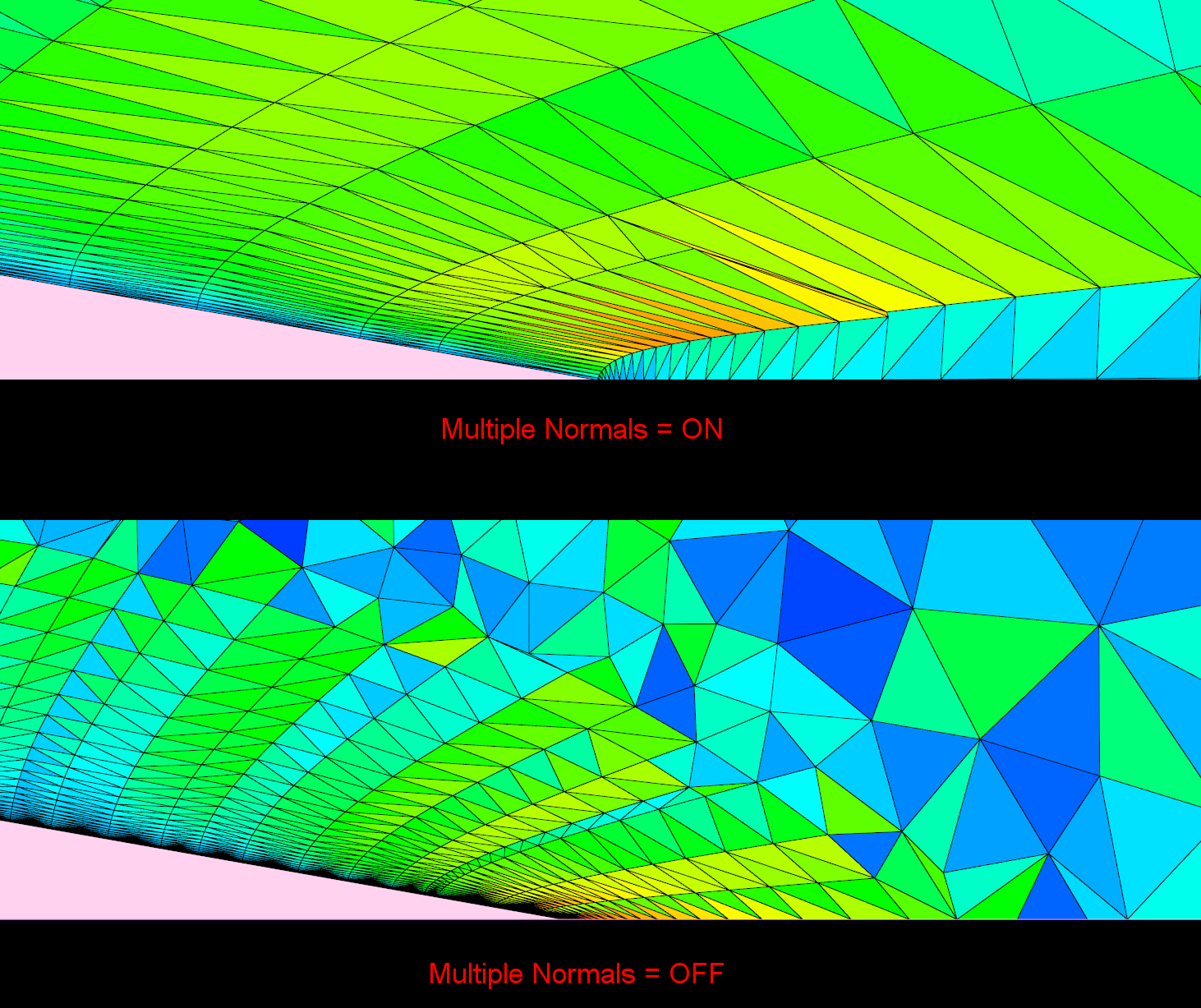
Growth Rate specifies the rate you wish to grow each anisotropic tetrahedral layer as layers deform from the boundary. Uncheck the Use Default toggle to override this setting's default value of 1.2 with your own rate value.
Push Attributes automatically propagates the block T-Rex attributes to domains set to a T-Rex Match boundary condition (refer to the Boundary Conditions section for more information). Specifically, the initial spacing, the number of layers, and distribution of points on the interior of the T-Rex block will automatically be matched on these domains. In addition, the corresponding connectors on these domains will also have their distributions updated to match the T-Rex volume. This option provides great time savings by avoiding the need for manual matching of T-Rex blocks and their perimeter domains and connectors.
Note: If Push Attributes is on, and a domain with the T-Rex Match boundary condition is shared with an extruded block, a warning dialog will be presented that the extruded block will be emptied and classified as Undefined in the List. You will have the options to Continue or Cancel. This check and warning will occur when Initialize is used in the Solve command panel or on the toolbar.
Cell Types
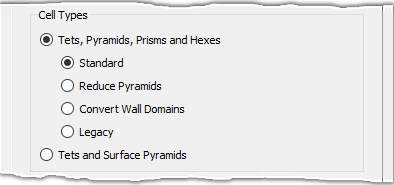
The Cell Types frame provides five options (organized in two groups) to specify the type of cells to be generated by the T-Rex algorithm (i.e. the types of cells in the anisotropic region of the volume grid):
- Standard: Creates anisotropic layers containing all of the volume cell types currently supported: tetrahedra, pyramids, prisms, and hexahedra. Stacks of anisotropic tetrahedra are grown off of surface triangles and quads (represented with 2 triangles) until a satisfactory transition cell is achieved. Subject to quality criteria, T-Rex anisotropic tetrahedral cell stacks which originate from triangles and quads are combined into prisms and hexes, respectively. At the top of each hex stack a cap is created from a pyramid surrounded by four side pyramids and topped by two inverted tetrahedra which interface with the isotropic volume of the block outside the T-Rex layers.
- Reduce Pyramids: Creates anisotropic layers using approximately the same workflow as the Standard option with one difference — the cap at the top of each hex stack is created from a single height-optimized pyramid whose four exposed triangles interface with the isotropic volume of the block outside the T-Rex layers.
- Convert Wall Domains: Creates anisotropic layers using approximately the same workflow as the Standard option with one difference — all fully triangular unstructured domains assigned to T-Rex boundary conditions of type Wall (refer to the Boundary Conditions section for more information) are converted to quad-dominant (refer to the Algorithm section for more information).
- Legacy: Creates anisotropic layers using approximately the same workflow as the Standard option with one difference — each surface quad is represented with 4 triangles instead of 2. This older variation on the algorithm is provided for backwards compatibility for legacy meshes.
- Tets and Surface Pyramids: Creates anisotropic layers containing only tetrahedra and pyramids. Note that the T-Rex algorithm includes pyramid cells only if any of the boundaries of an unstructured block contains structured or quad-dominant domains. Wherever quad cells are included in an unstructured face, pyramid cells are used to transition from the quad cells in the face to the unstructured (tetrahedral) volume grid.
Caution: Note that in isolated cases, the T-Rex algorithm could diagonalize quadrilateral cells in unstructured wall domains in order to improve the quality of the generated volume isotropic cells.
In general, when any of the Cell Types options other than Convert Wall Domains is selected, the T-Rex algorithm does not change the cell topology of the unstructured bounding domains assigned to a T-Rex boundary condition of type Wall (refer to the Boundary Conditions section for more information). However, in isolated cases, a reduced number of quadrilateral cells in these domains may be split in order to improve the quality of the created anisotropic volume cells.
The image below illustrates a typical case where the T-Rex algorithm splits a reduced number of quadrilateral cells in the bounding unstructured domains (shown in bright green) in order to improve the quality of the final (prism) anisotropic cells. In the image, we compare two cases with the exact same geometry. In one case, some of the bounding domains are structured (shown in red); their cells cannot be split. In the other case, the same bounding domains are quad-dominant unstructured (shown in bright green) and their quadrilateral cells can be split by the T-Rex algorithm as needed. The two enlarged images on the right side show that when the quadrilateral cells cannot be split (red structured domain), the T-Rex algorithm places pyramid volume cells which reach a maximum included angle of 172 degrees. On the other hand, when the quadrilateral cells can be split as needed (green unstructured domain), the T-Rex algorithm, splits them in order to place anisotropic prisms with a much lower maximum included angle of 92 degrees.

From the comments above, it can be inferred that one way to prevent the T-Rex algorithm from splitting quadrilateral cells in wall domains to improve quality it by making those domains structured. An alternative way to reduce the number of quadrilateral cells split by the algorithm is to relax the quality constraints; this could be accomplished by increasing the specified Max. Angle parameter in the Skew Criteria frame described below.
Advanced
Use the options in the Advanced frame to change the Isotropic Seed Layers, Collision Buffer, Aniso-Iso Blend, and Isotropic Height attributes.

Isotropic Seed Layers sets the maximum number of layers of seed points, or vertices, to be created in the isotropic regions adjacent to anisotropic cells that have stopped before reaching isotropy due to one of the following reasons: achievement of the specified maximum number of anisotropic layers (Max. Layers), cell collision, or failure of cell skew criteria. These additional vertices are marched out from the anisotropic tetrahedra based on their defined attributes such as growth rate and layer height. This input defaults to off, or 0. If the Use Remaining checkbox is checked on, this parameter will be set locally to the difference between the value specified in Max. Layers and the maximum number of anisotropic layers actually achieved. Note that the T-Rex algorithm will locally stop adding seed points, independently of the value of this parameter, once isotropy is locally reached.
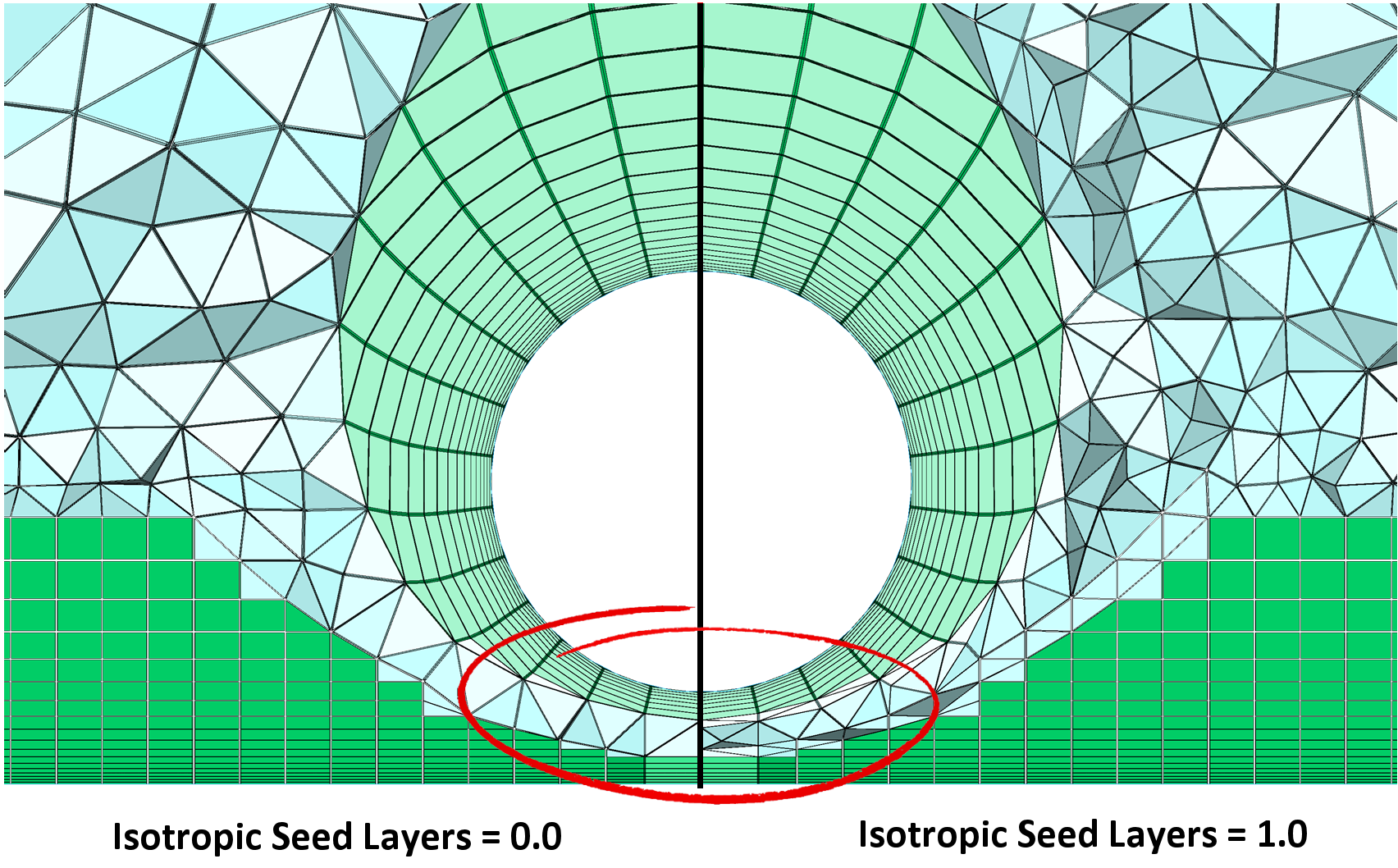
Collision Buffer specifies the minimum buffer to be maintained between encroaching advancing tetrahedra, in terms of multiplicative factors of the current cell height. For example, with a factor of 0.5, a grid point will be advanced by a distance of 0.01 only if it may also be advanced by a distance of 0.015 without intersecting any other portion of the front. Values must be non-negative. The default value of this parameter is 2.0.
Aniso-Iso Blend specifies the floating-point rate with which anisotropic 2D cells on a block's T-Rex front are blended into isotropic 2D cells with each marching step. This blending of the 2D cells is achieved by means of a local decimation on the T-Rex front as the algorithm progresses. The image bellow shows the effect of this parameter on a volume grid. In particular, the central image displays the decimation of the T-Rex front enclosed in the red circle.
Note that larger values of this parameter decrease the number of layers and distance over which the anisotropic to isotropic transition occurs (resulting in a faster transition). Values must lie between 0 (disabled blending) and 1 (maximum blending).
Isotropic Height specifies a scaling factor used to scale the normal isotropic cell height of a vertex. This will allow the T-Rex algorithm to grow anisotropic cells past the isotropic state (factor larger than one) or to stop the growth of anisotropic cells before they reach the isotropic state (factor smaller than one).
Caution: Although setting the Acceleration slider to maximize Performance typically results in faster initialization times, the overall quality of the cells may be degraded.
The Acceleration sub-frame provides options for accelerating T-Rex initialization times. The Quality-Performance slider accelerates T-Rex initialization by advancing multiple layers at a time. Uncheck the Use Default checkbox and move the slider towards Performance to increase the number of layers T-Rex advances during each step. The Layer Subdivisions label below the slider denotes the maximum number of layers that could be advanced during each T-Rex step, subject to the isotropic stop condition. Acceleration ranges from Quality (1 Layer Subdivision) to Performance (5 Layer Subdivisions), with a default setting of Quality.
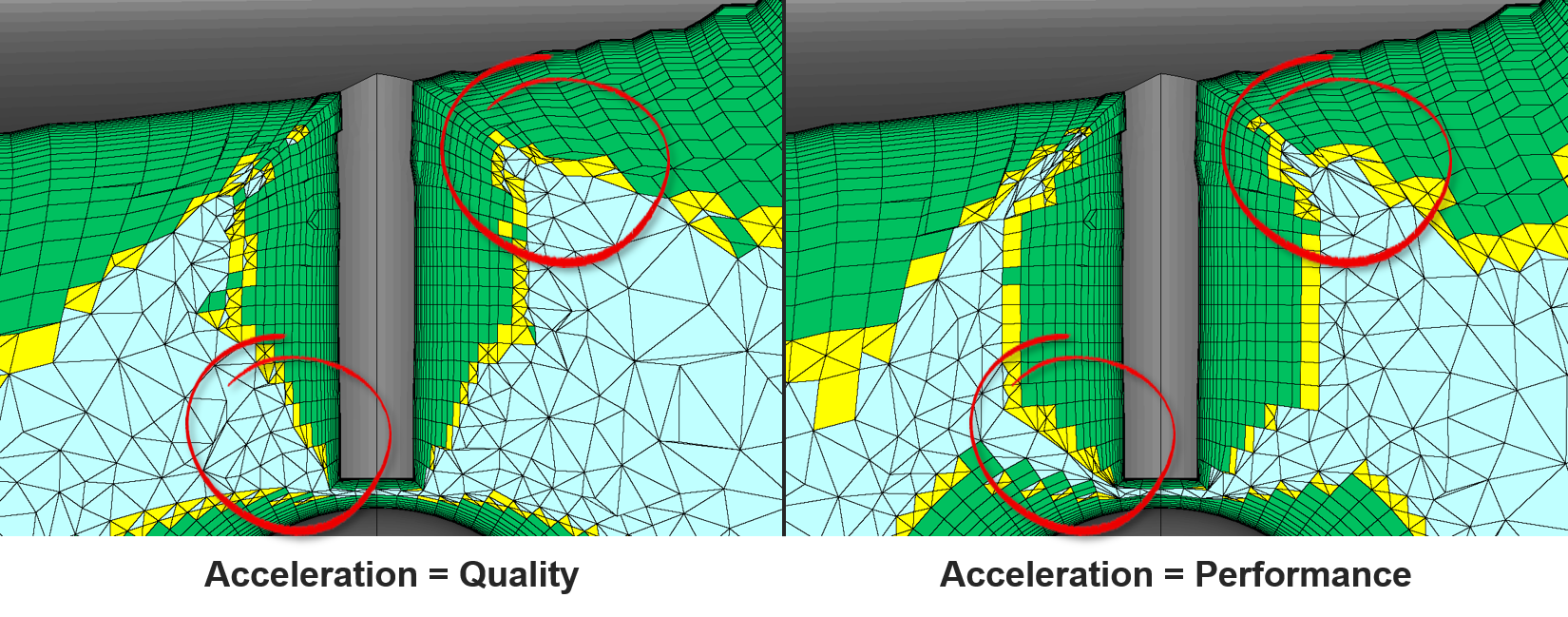
Caution: T-Rex Acceleration currently requires that match quadrilateral cells be diagonalizable. That is, any domain containing quads that is set to a Match T-Rex boundary condition must be unstructured and Push Attributes must be enabled. If T-Rex detects that a Match domain containing quads is structured or that Push Attributes is disabled, Acceleration will instead be limited to the default of 1 for Layer Subdivision.
When the Use Collision Prediction checkbox is checked, T-Rex estimates the distance at which collisions are likely to occur for each advancing point. Collision checks are then disabled until the advancing front approaches the estimated collision distance. This results in costly collision checks only being evaluated in regions where it is needed (such as in concave corners or narrow passages with colliding fronts). Uncheck Use Collision Prediction to specify that T-Rex perform collision checks for every point advancement. Use Collision Prediction is enabled by default.
Tip: For large meshes, using both Acceleration methods simultaneously (i.e. setting Layer Subdivisions > 1 and enabling Use Collision Prediction) offers a small additional boost in speedup over using collision prediction alone.
Skew Criteria
Use the Skew Criteria attributes to enforce additional quality control measures on the tetrahedra, pyramids, prisms and hexahedral cells formed by the T-Rex algorithm.
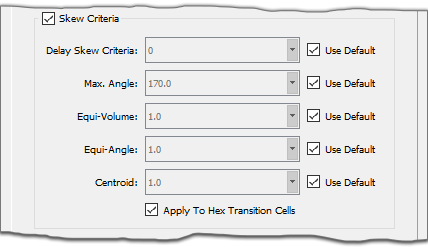
The Skew Criteria frame (figure above) provides input fields for quality measures applied to all newly formed tetrahedra, pyramids, prisms, and hexahedra as the T-Rex layers advance. The parameters on this frame are all disabled by default. Delay Skew Criteria delays the use of all the skew quality constraints for the specified number of layers. The input value must be less than or equal to Max. Layers. Once the input number of layers have been formed, cells failing the specified skew criteria will not be added to the mesh.
Max. Angle specifies the maximum included face and dihedral angle quality threshold for anisotropic cells (refer to the Maximum Included Angle section for more information). Anisotropic cells with angles above the threshold will be modified locally in an attempt to satisfy the criterion. If the criterion cannot be met, the anisotropic element is discarded and the front is stopped locally. The specified threshold must be a floating-point number between 60 (i.e. isotropic tetrahedron) and 180 (i.e. collapsed). The default value is 170.0.
Equi-Volume specifies the volume skew quality threshold for anisotropic cells (refer to the Equiarea, Equivolume Skewness section for more information). Anisotropic cells with measures above the threshold will be modified locally in an attempt to satisfy the criterion. If the criterion cannot be met, the anisotropic element is discarded and the front is stopped locally. The specified threshold must be a floating-point number between 0 (i.e.perfect quality) and 1 (i.e. collapsed). The default value is 1 (i.e. no quality check).
Equi-Angle specifies the angle skew quality threshold for anisotropic cells (refer to the Equiangle Skewness section for more information). Anisotropic cells with measures above the threshold will be modified locally in an attempt to satisfy the criterion. If the criterion cannot be met, the anisotropic element is discarded and the front is stopped locally. The specified threshold must be a floating-point number between 0 (i.e. perfect quality) and 1 (i.e. collapsed). The default value is 1 (i.e. no quality check).
Centroid specifies the centroid skew quality threshold for anisotropic cells (refer to the Centroid Skewness section for more information). Anisotropic cells with measures above the threshold will be modified locally in an attempt to satisfy the criterion. If the criterion cannot be met, the anisotropic element is discarded and the front is stopped locally. The specified threshold must be a floating-point number between 0 (i.e. perfect quality) and 1 (i.e. collapsed). The default value is 1 (i.e. no quality check).
Apply To Hex Transition Cells specifies whether or not to apply the skew criteria constraints to the transition cells at the top of hex stacks and is enabled by default. When disabled, the only constraints applied to the hex transition cells are the volume criteria constraints, which ensure cell validity. This control is intended to be used to prevent surface quadrilaterals from being diagonalized due to quality issues in the transition cells. Note that disabling the skew criteria can result in lower overall cell quality.
Caution: Unchecking Apply To Hex Transition Cells disables skew quality checks on hex transition cells, which can result in a lower cell quality. It is recommended to uncheck Apply To Hex Transition Cells only if your solver is sensitive to anisotropic tetrahedra and prisms near the surface.
Smoothing
Use the Smoothing frame to adjust T-Rex smoothing parameters.

The Smoothing frame (figure above) provides input fields for Smooth and Relax controlling local cell height Laplacian smoothing. Smooth is the number of smoothing iterations to be applied. Relax is a factor controlling the influence of the smoothing, varying between 0 and 1. For both parameters, uncheck Use Default to override the default values.
Volume Criteria
Use the Volume Criteria attributes for further volume quality settings.

In the Volume Criteria frame, the Volume Computation Method pull-down allows you to choose a method by which volumes are calculated for quality verification. The default, Min. Component Volume, is determined in the same fashion as for the Examine diagnostic of the same name (refer to the Component Volume section for more information).
Green-Gauss Volume is a much less demanding volume quality check which may result in more anisotropic layers but probably with a higher number inferior cells. This volume is computed by decomposing any quad cell faces into triangles with a common vertex at the quad’s weighted centroid. All cell face triangles then have their area multiplied by the triangle normal, dotted with the X directed unit vector and summed to form the cell’s volume.
Tip: The more quality measures you enforce on your T-Rex layers the less layers you will likely get as more stringent criteria force the checking to stop advancing the front in more areas. Therefore, try to be as relaxed as possible on quality criteria settings.
